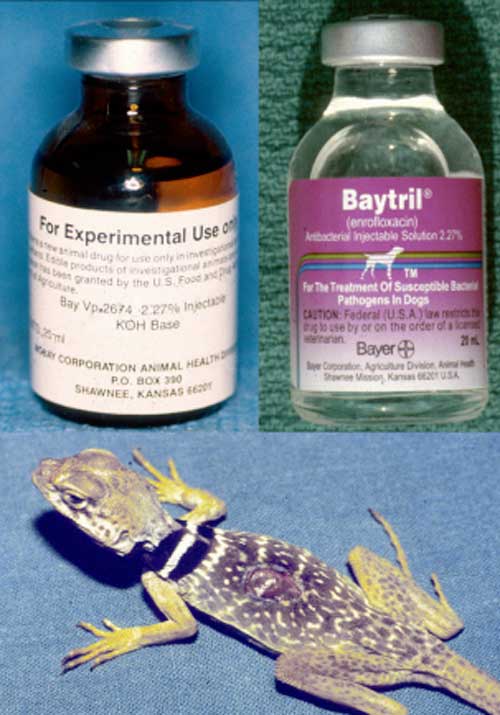Baytril is an excellent, powerful and effective drug.
I’ve discussed antibiotics multiple times in this column over the years, and I’ve specifically addressed the antibiotic Baytril as part of those reviews. However, I have not dedicated a column solely to Baytril in about 20 years, back when I was fielding questions from readers. Surprisingly, not much has changed with this drug since that time, and it remains one of the most common drugs used in herps. It also is probably one of the most misused antibiotics in herps.
I host a senior veterinary student program in my hospital. On the first day of their rotation, when I review the protocols of their preceptorship, one of the “Mader’s Laws” is that they are not allowed to use Baytril in any exotic pet for the entire month they are with me. Why? Because this drug is so overused that I want them to learn when it should be used, and what alternatives are available. Baytril always has been considered a big gun in antibiotic choices. In reality, it should be reserved for cases that require advanced therapy.

Douglas Mader
Baytril is an excellent, powerful and effective drug. Unfortunately, it tends to be overused in exotic animal medicine, especially with herps.
Manufactured by Bayer, Baytril is the trade name for the antibiotic enrofloxacin. It is one of a group of antibiotics termed fluoroquinolones, which were introduced into clinical medicine in 1967. The original fluoroquinolones had a lot of side effects, which ultimately led to further research and the development of enrofloxacin in the mid-1980s. I was one of the first clinical researchers to use Baytril, so my experience with the antibiotic dates back three decades.
Thanks to its chemical design and clinical effectiveness, Baytril rapidly became popular in herps and other exotics. Its early success led to widespread use—and misuse—in lay herpetoculture. In a perfect world, antibiotic selection should be based on laboratory analysis, known as culture and sensitivity testing. For example, when you go to your doctor with a sore throat, he or she might swab your tonsils in an attempt to isolate the cause of your illness, such as strep throat. The culture then is tested against several antibiotics, and the results support which antibiotic choice is best for you, as a patient.
Read More
Reptile Medicine: It’s Not Always Fun
In lay herpetoculture, Baytril often is reached for as the first drug of choice, without the benefit of culture and sensitivity testing, without veterinary diagnosis of infection, and without knowledge of appropriate dosages and treatment schedules. Past experience tells us that such indiscriminate and widespread use of an antibiotic risks production of antibiotic-resistant bacteria. In many cases, less-powerful antibiotics would be equally effective without Baytril’s cost or potential side effects.
There are no FDA-approved drugs available in this country for reptiles; almost all of the drugs we use in exotic animal medicine are formulas intended for use in dogs and cats. As a result, whenever we use these drugs, it is called extra-label. Herp veterinarians always are challenged to find better ways to treat our patients. Only in the last decade or so have scientists conducted research in the field of drug dosing (called pharmacokinetics) and drug effects (called pharmacodynamics) for herps. As we learn more about drugs in all the different species we treat, the more effective we will be.
Enrofloxacin Beginnings
Enrofloxacin has an interesting history. The antibiotic originally was intended for use in human medicine. Because of the side effects in people, however, it was relegated for use in veterinary medicine. After some changes in the chemistry of the enrofloxacin formula, a new drug, called ciprofloxacin, was made. Interestingly, in some animals, when enrofloxacin is given, the body partially biotransforms it to ciprofloxacin.
In humans, enrofloxacin has greater oral absorption than ciprofloxacin. It originally was marketed in veterinary medicine only as an oral pill form, but, after pressure from veterinarians, Bayer produced an injectable form of the drug. The injectable Baytril only was intended for administration as a single injection, and then the patient was to be switched to the oral tablet form.
Why? Because the carrier formulation (KOH) of the injectable Baytril is alkaline, with a pH of 11. The normal pH of body fluids is slightly above 7. So, clinically, Baytril injections can cause serious, sterile injection site abscesses. Not every injection will cause an abscess, but if you are around Baytril long enough, you will see it. And just because you don’t see an abscess on the skin does not mean there is not an unseen tissue reaction inside.
Baytril can be given orally, even to reptiles. The problem is that other than the tablets, there is no oral suspension available commercially. Although suspensions can be made by licensed compounding pharmacies in special circumstances, the preparations have not been tested in all the different species, so there is no way to know that proper concentrations of the drug actually are being achieved.
The bottom line is that Baytril is an excellent, powerful and effective drug. Unfortunately, it tends to be overused in exotic animal medicine, especially with herps. To use an old adage, there is no reason to use a hammer when a fly swatter will do the job just as well. Baytril is definitely a hammer.
Always check with your knowledgeable herp vet before administering any antibiotic.
Douglas R. MADER, MS, DVM, DABVP (C/F, R/A), DECZM (HERPETOLOGY), is a graduate of the University of California, Davis. He owns the Marathon Veterinary Hospital in the Conch Republic, and is a world-renowned lecturer, author and editor. He sits on the review boards of several scientific and veterinary journals.


